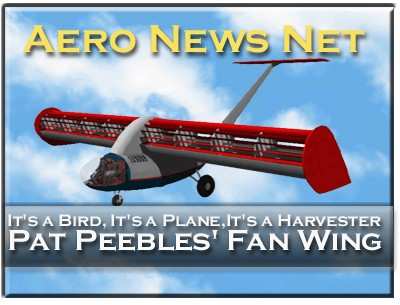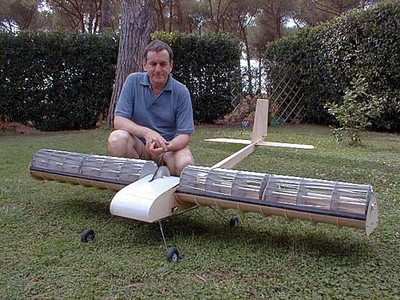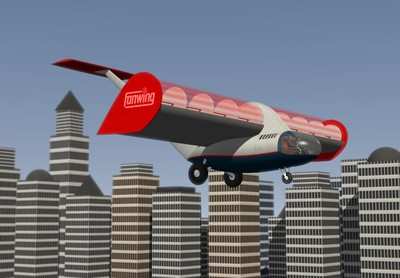Pat Peebles Ready To Stand Aviation World On Its Ear
Pat Peebles has heard it all.
"Is that a harvesting combine?"
"Can that thing cut my grass?"

That "thing" is what Peebles -- the man who invented the
rotating fork for eating spaghetti -- calls a "fan wing" aircraft.
It has rotors that span almost the entire length of each wing.
 "Part of inventing," he told the
Independent newspaper in Britain, "is trying to improve things, but
it's partly just being bloody-minded and wanting to do things
differently. A lot of the things that I've worked on in the past
didn't actually work out very well. But the fan wing actually
worked out."
"Part of inventing," he told the
Independent newspaper in Britain, "is trying to improve things, but
it's partly just being bloody-minded and wanting to do things
differently. A lot of the things that I've worked on in the past
didn't actually work out very well. But the fan wing actually
worked out."
So what's a fan wing aircraft all about?
"The genesis of the idea," he told the paper, "was to distribute
the flow of air as far as possible over the aircraft. We take that
to the extreme, sucking the air in through the front over a rather
large area, the whole width of the fan. It compresses the air as it
comes through the fan and it gets blown out at very high speed
across the wing's trailing edge."
When he dreamed up the fan wing, he had no idea whether it would
work. In fact, he didn't know whether somebody else had already
invented it.
"Many years ago," he told the Independent, "I worked on a new
engine which employed hot air, where air was moved from one section
to another and heated and cooled at very high speed."
Peebles built a prototypical model of his fan wing, testing it
in the parking lot of a local supermarket. It flew. He tweaked it.
It flew better. Then, in 1999, came time to apply for a patent.
Suddenly, Peebles found he needed about $36,000 to complete the
application process.
"I was ready to quit," Pat told the paper, "because I realized
there was no way privately that I could raise that much money, and
I wasn't going to put the family into that kind of debt."

But Peebles and his wife decided to "collaborate." They rounded
up the necessary money from family and friends and wound up with
$1,800 more than they needed. Fan Wing PLC was born, complete with
its own web site.
Another lucky break: Peebles met David Nicholas, a former naval
architect-turned technology consultant. He advised Peebles to set
up a company, name respected engineers to an unpaid board of
directors, and gain some credibility. Before they knew it, Peebles
and Nicholas had a $85,000 grant from the British government in
their pockets.
They used the money to come up with an even better model than
the one Peebles developed in that supermarket parking lot.
"It was absolutely fabulous," Pat recalled. "We doubled the
efficiency in two weeks of wind tunnel testing. It was very
exciting because, being a new device, very small changes can make
big changes in the efficiency. People are still trying to tweak
conventional aircraft but they're lucky if they get half a per
cent, maybe one per cent, change in efficiency. But at this early
stage, there was one point where we moved a little section of the
wing by 10mm and got a 30 per cent increase in efficiency."

It was remarkable work, according to Nicholas. "An employee of
British Aerospace told me that Pat got more out of that
�45,000 than British Aerospace would have got out of
�4 million."
Nicholas said, when he first saw a laptop video of the flight of
an early model of the Fan Wing, "I was blown away by its
astonishing performance. It can go very slowly like a helicopter,
but it can carry much heavier loads. Pat doesn't like me saying
this, but I regard his plane as the fourth great breakthrough in
aeronautical science: there was Orville and Wilbur Wright,
Sikorski's helicopter, Sidney Camm's jump jet, and Pat Peebles and
the fan wing."
"It's quieter than a helicopter of the equivalent weight,"
Peebles told the Independent. "They've been trying for years to get
permission to fly helicopters into Heathrow for commuters out of
the bankers' belt, and they never can because they make too much
noise. So this could be very useful for connecting for example the
five airports around London, a flying bus going maybe 60, 80mph,
maybe 100 mph."
 ANN's Daily Aero-Term (04.14.24): Maximum Authorized Altitude
ANN's Daily Aero-Term (04.14.24): Maximum Authorized Altitude ANN's Daily Aero-Linx (04.14.24)
ANN's Daily Aero-Linx (04.14.24) Classic Aero-TV: 'We're Surviving'-- Kyle Franklin Describes Airshow Life 2013
Classic Aero-TV: 'We're Surviving'-- Kyle Franklin Describes Airshow Life 2013 Aero-News: Quote of the Day (04.14.24)
Aero-News: Quote of the Day (04.14.24) Airborne 04.09.24: SnF24!, Piper-DeltaHawk!, Fisher Update, Junkers
Airborne 04.09.24: SnF24!, Piper-DeltaHawk!, Fisher Update, Junkers






